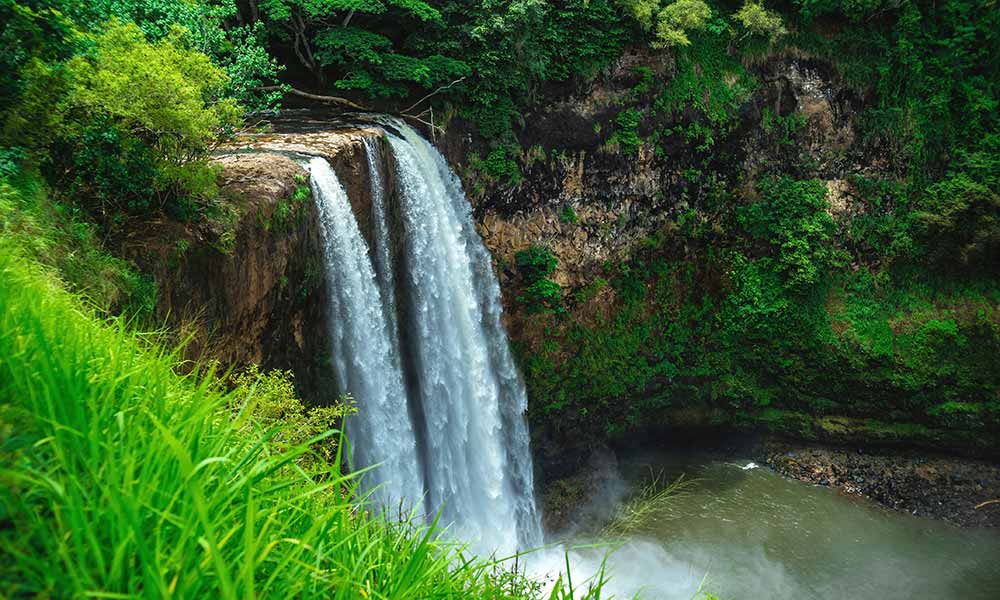Waimea Waterfall on the island of Oahu offers hikers the unique opportunity to discover Hawaii’s spectacular fauna and learn more about the country’s fascinating heritage and their traditional way of life amid a tropical paradise conserved for future generations.
The hike to Waimea Waterfall is 3.5 miles long which takes up to an hour to complete. However, the family-friendly paved trail is primarily flat with limited slopes; thus, it cannot be considered a strenuous hike. There are also various side paths through botanical gardens that resemble lush tropical islands.
Although it could be argued that the Waimea Waterfall trail constitutes a gentle stroll and not a hike, there are few places in Hawaii where you can enjoy the region’s diverse and exquisite botany and learn something along the way.
So, if you want to know more about this tropical paradise and what the region has to offer, read on!
The Waimea Waterfall Hiking Trail Length
The Waimea Waterfall, commonly known as the Waihi Falls, is in Oahu’s picturesque Waimea Valley in Hawaii, a fascinating archaeological site steeped in history.
The botanical garden or nature reserve was established to showcase the region’s spectacular tropical plant life and nurture and protect the country’s rich cultural heritage with informative Hawaiian village recreations and other informative exhibits.
While you will have to pay an entrance fee for the botanical garden’s upkeep, it’s a great outing if you plan to spend a few hours exploring the magnificent garden or swim in the crystal-clear pool surrounded by lush tropical foliage.
While the 3.5-mile trail to the Waimea Waterfall can be wet and foggy during the rainy season, it’s a great family-friendly paved trail and perfect for baby strollers, including toddlers learning to walk.
The trail takes 25 minutes to an hour to complete and can technically not be called a hike due to the path’s slight slopes, so you will certainly not get a great workout, although that might be great if you are looking for a leisurely walk.
There are numerous side trails that meander through the botanical gardens, representing various tropical islands. While the botanical garden showcases native plant species, it also features exotic plants imported from across the globe.
It should likely take you about two hours to stroll through the side paths, which are dotted with numerous fascinating historical sites. It is a great way to make the most of your excursion, including the entrance fee.
Key Safety Considerations
Due to the wet conditions in the botanical garden, wear sturdy waterproof hiking boots or pack a pair of water shoes for the slippery waterfall area, including swimwear and a towel if you plan to swim in the beautiful waterfall pool.
Most importantly, cover yourself with sunscreen and wear a cap as the shady botanical garden will not provide adequate protection on sunny days, especially if you spend countless hours in the nature reserve.
Just a word of warning, there are also numerous bugs around the waterfall area, so grab your bug spray when you head out for the day.
While the Waimea Valley staff monitor the waterfall’s bacteria levels and have been known to close the area off to visitors at times, all Hawaii freshwater sources are prone to bouts of Leptospirosis bacteria. So, it would be wise not to drink the water or swim in the pool with any open sores.
The nature reserve has change facilities for anyone who would like to enjoy swimming in the pool, including mandatory free vests. Although the pool is a little crowded at times, and the water is slightly chilly, it’s a refreshing method to cool down on a hot summer’s day.
The Beautiful Waimea Waterfall
The 45-foot (13.7m) Waimea Waterfall is an outlet of the Kamananui stream that flows from the northern end of the spectacular Koolau Mountains on the Windward end through the scenic Waimea Valley, joins up with the Waimea River leading to the ocean.
The word “Waimea,” which means “red-colored water” in Hawaiian, emanates from the waterfall’s Kamananui Stream floods its riverbanks which contain red-colored volcanic soil, resulting in a red-tinted waterfall.
It’s important to note that visitors have been disappointed with the waterfalls more diminutive than a spectacular trickle, which is common during dry spells in late summer. So, no wonder it has also been called the Waihi Falls, which refers to “tickling water.”
The Waimea Falls is also referred to locally as the Waihe’e Falls, which means a water slide. But, unfortunately, it would not be such a great idea!
While the commercialized Waimea Waterfall cannot be compared with the natural splendor of, for example, the Hawaiian Manoa Falls, it’s perfect for cooling down on a hot sunny day.
Especially if you like the idea of swimming in natural waterfalls in a relatively safe and comfortable environment, then Waimea Falls might be for you!
Moreover, the Waimea Waterfall is open to visitors seven days a week from 9 AM to 5 PM if the pool has been deemed safe to swim in.
Explore Oahu’s Other Great Attractions
If you still have time (and energy) to spare, explore Waimea Bay which is just opposite the botanical gardens and is known as one of the most stunning beaches on the North Shore.
Alternatively, enjoy Oahu’s finest snorkeling spot at Sharks Cove, and stop along the way to buy snacks for an impromptu picnic with spectacular views of the ocean.
To reach the iconic Waikiki Beach, stopover at Kaiulani Avenue’s lush garden named in honor of a Hawaiian princess, then head over to Kalakaua Avenue.
Here you will be greeted with spectacular views of the palm-lined beachfront with luxury hotels dotted along the way. It’s the most place to watch the sun go down over the sublime Pacific Ocean.
Conclusion
While the 3.5-mile trail to the Waimea Waterfall is not a strenuous hike and might disappoint avid hikers, it’s the perfect destination for nature enthusiasts who love nothing more than enjoying nature’s bounty in a magnificent setting.







